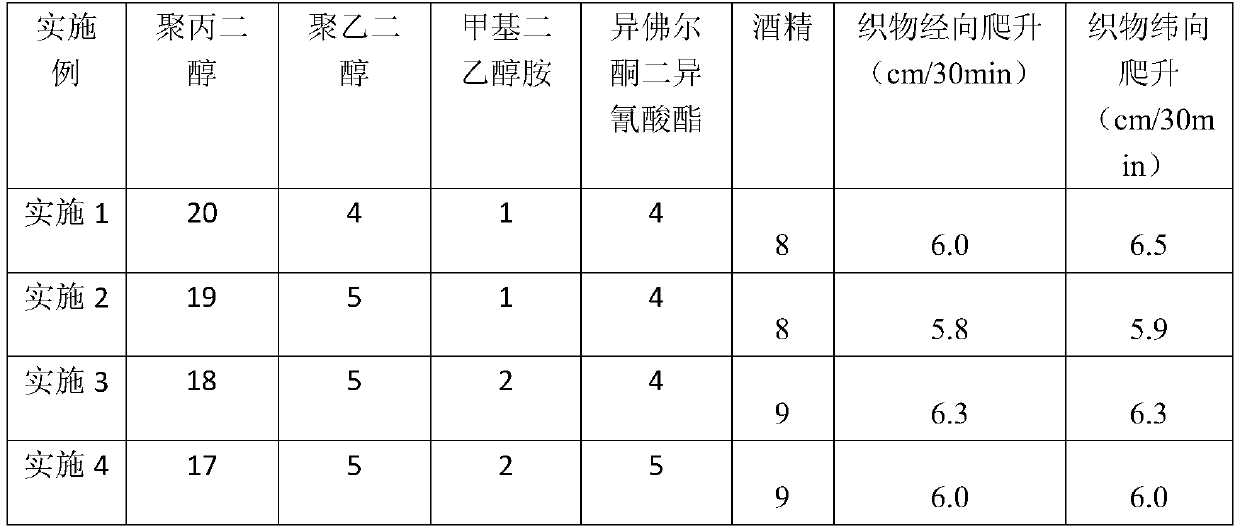Preparation method of washable polyurethane finishing agent for moisture absorption and sweat releasing
A moisture-wicking, polyurethane technology, used in fiber processing, textiles and papermaking, etc., can solve the problems of blocked pores, poor see-through performance, and low water absorption
- Summary
- Abstract
- Description
- Claims
- Application Information
AI Technical Summary
Problems solved by technology
Method used
Image
Examples
Embodiment 1
[0023] 1. In a 500ml glass reaction kettle, add 20 parts of polypropylene glycol, and at the same time, start stirring at a speed of 200rpm, and heat;
[0024] 2. After the feeding is completed, the temperature of the material can be raised to 65°C, and the stirring is stopped;
[0025] 3. Add 4 parts of polyethylene glycol (solid, needs to be heated and melted), raise the temperature to 100°C, observe whether it melts into a liquid, and start stirring after it is basically liquid, at a speed of 200rpm;
[0026] 4. Start vacuuming to remove water, the water removal temperature is 120°C, the water removal time is 2 hours, and the water removal pressure is -0.099MPa; after the water removal is completed, stop the vacuum;
[0027] 5. Introduce nitrogen gas for flat pressure and ensure that the kettle maintains a slight positive pressure, so that the temperature of the material is cooled to 100.0±5°C, and the cooling is stopped;
[0028] 6. Reduce the stirring speed, adjust the r...
Embodiment 2
[0034] 1. In a 500ml glass reaction kettle, add 19 parts of polypropylene glycol, and at the same time, start stirring at a speed of 200rpm, and heat;
[0035] 2. After the feeding is completed, the temperature of the material can be raised to 70°C, and the stirring is stopped;
[0036] 3. Add 5 parts of polyethylene glycol (solid, needs to be heated and melted), raise the temperature to 100°C, observe whether it melts into a liquid, and start stirring after it is basically liquid, at a speed of 200rpm;
[0037] 4. Start vacuuming to remove water, the water removal temperature is 120°C, the water removal time is 2 hours, and the water removal pressure is -0.099MPa; after the water removal is completed, stop the vacuum;
[0038] 5. Introduce nitrogen gas for flat pressure and ensure that the kettle maintains a slight positive pressure, so that the temperature of the material is cooled to 100.0±5°C, and the cooling is stopped;
[0039] 6. Reduce the stirring speed, adjust the r...
Embodiment 3
[0045] 1. In a 500ml glass reaction kettle, add 18 parts of polypropylene glycol, at the same time, start stirring at a speed of 200rpm, and heat;
[0046] 2. After the feeding is completed, the temperature of the material can be raised to 65°C, and the stirring is stopped;
[0047] 3. Add 5 parts of polyethylene glycol (solid, needs to be heated and melted), raise the temperature to 100°C, observe whether it melts into a liquid, and start stirring after it is basically liquid, at a speed of 200rpm;
[0048] 4. Start vacuuming to remove water, the water removal temperature is 120°C, the water removal time is 2 hours, and the water removal pressure is -0.099MPa; after the water removal is completed, stop the vacuum;
[0049] 5. Introduce nitrogen gas for flat pressure and ensure that the kettle maintains a slight positive pressure, so that the temperature of the material is cooled to 100.0±5°C, and the cooling is stopped;
[0050] 6. Reduce the stirring speed, adjust the rotat...
PUM
 Login to View More
Login to View More Abstract
Description
Claims
Application Information
 Login to View More
Login to View More - R&D
- Intellectual Property
- Life Sciences
- Materials
- Tech Scout
- Unparalleled Data Quality
- Higher Quality Content
- 60% Fewer Hallucinations
Browse by: Latest US Patents, China's latest patents, Technical Efficacy Thesaurus, Application Domain, Technology Topic, Popular Technical Reports.
© 2025 PatSnap. All rights reserved.Legal|Privacy policy|Modern Slavery Act Transparency Statement|Sitemap|About US| Contact US: help@patsnap.com

